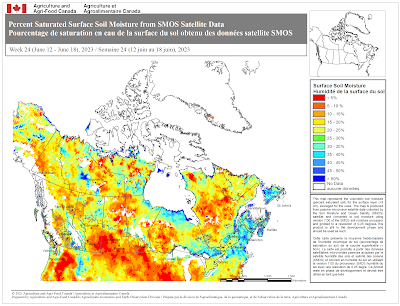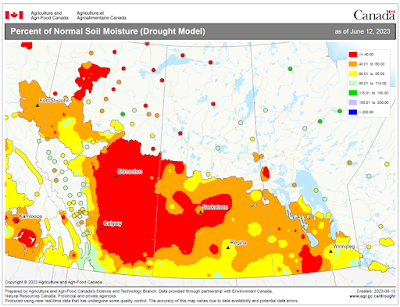Background
June is an important month in terms of field crop pathogen
and disease development for Prairie farmers.
For cereals and pulses initial leaf disease infections occur and with
favourable weather conditions secondary development and spread takes place. Fungicide use decisions for these leaf
diseases can be based partly on disease symptoms, but also consideration of
weather and host factors. Key weather
and host considerations include the occurrence of frequent rainfall, moderate
temperatures (15-25oC), level of disease resistance, crop yield
potential/canopy density, and commodity prices.
Previous PCDMN posts discussed scouting for leaf disease in cereals and
fungicide use decisions. See: https://prairiecropdisease.blogspot.com/2022/06/scouting-and-risk-assessment.html.
For diseases such as sclerotinia stem rot of canola and
ergot of small grain cereals, suitable pathogen development must occur to
produce spores before host infection can take place. The pathogens associated with both diseases
overwinter as resting bodies known as sclerotia, which are compact masses of
hyphae (Figure 1). Germination of stem
rot sclerotia to produce the golf-tee shaped apothecia, aka carpogenic
germination, requires sufficient soil moisture and moderate temperatures. Typically, germination takes up to three
weeks with the occurrence of temperatures that range from 10 to 20oC
with soil water potentials of about 0 to 500 kPa, although germination is
reduced as kPa increases to >=300-500 kPa (Abawi and Grogan 1975; Boland
1984; Boland and Hall 1988; Clarkson et al. 2004; Hao et al. 203; Teo and
Morrall 1985a,b). These conditions
typically occur for Prairie crops with adequate rainfall following canopy
closure over the soil surface, which helps to buffer temperature and moisture
fluctuations.
Soil water (matric) potential is a measure of how closely
water is held by soil particles and pores (Datta et al. 2017; Irmak 2019). Soil volumetric water content (VWC) is
related to the ratio of soil water volume and the volume of the soil and is
expressed in percentages. The
relationship between VMC and soil matric potential varies depending on soil
texture and is expressed through a soil water characteristic curve for each
soil type . When soils approach
saturation (0 kPa) the VMC will be up to 45% for clay textured soil, while for
sandy soils this value is 30%. Once soil
water potential increases above 300 kPa plant root access to water will be
increasingly difficult, while for soils overall the permanent wilting point of
a plant is generally considered to be reached around 1,500 kPa (Datta et al.
2017).
PCDMN weekly soil moisture maps
Starting in mid to late June in 2023 the PCDMN will be
posting weekly soil moisture maps to help farmers and consultants identify
regions where rainfall has occurred, and soil moisture levels are potentially
favourable for germination of sclerotia and production of apothecia of the stem
rot pathogen. For regions with
favourable soil moisture conditions, farmers and consultants are encouraged to scout
for apothecia and also use in-field sclerotinia stem rot risk assessment tools
including the checklist, as well as measures of aerial spore load via petal
testing or spore trapping (https://www.canolacouncil.org/canola-encyclopedia/diseases/sclerotinia-stem-rot/#forecasting-and-risk-assessment). Fungicide use and timing decisions can be
improved by using these sources of information.
PCDMN related information for sclerotinia stem rot can be
found here:
https://prairiecropdisease.blogspot.com/p/scouting-tips-calendar.html
https://twitter.com/pcdmn/status/1143545235789811712
https://prairiecropdisease.blogspot.com/2022/08/prairie-crop-disease-monitoring-network.html
https://prairiecropdisease.blogspot.com/2020/08/suggested-protocols-for-assessing.html.
The PCDMN has been working with Agriculture and Agri-Food
Canada (AAFC) to obtain maps showing surface soil moisture based on satellite
observations. These soil moisture values
are in VMC and usually range from 5- 45% by volume and the relationship between
this value and the plant available water are affected by soil texture. For example, a dry sandy soil may have a volumetric
moisture content as low as 5% when dry, whereas the lower bounds for a clay textured
soil may be closer to 20% VMC. Soils
with a VMC of 40-60% would be wet/saturated, although the level of saturation
would vary based on soil texture, where a sandy soil may be saturated at 30% compared
to 40-60% for heavier textured or organic soils.
In addition to total soil moisture (i.e., VMC), AAFC also provides maps showing
the % difference from average over a specified period. Here +ve values
indicates the moisture is wetter than normal, while a –ve value indicates it is
dryer than normal. When you have a high
percentage difference, this would indicate the soil is either much wetter or
much drier than normal.
Prairie soil moisture levels and need to scout for apothecia of the sclerotinia stem rot pathogen, June 12, 2023
As June 12, 2023 most Prairie regions have well below normal
soil moisture levels with large areas with <40 to 60% of normal (Figure 2). Based on satellite data from June 5-11, 2023,
large areas of the Prairies would only have <5 to 20% surface soil moisture
(VMC) and as Figure 3 indicates, the corresponding satellite image shows well
below long term average soil moisture levels for large areas of the Prairies including
regions where sclerotinia stem rot can occur (Figure 4).
As of June 12, the need to scout fields for apothecia of
the stem rot fungus and/or to assess in-field risk is low. This is based on soil moisture maps (Figures
2-4) and that flowering in most canola crops is still 2-3 weeks away.
Disclaimer
Information related to soil moisture is OFFERED TO THE PUBLIC FOR INFORMATIONAL PURPOSES ONLY.
Agriculture and Agri-Food Canada, and their employees assume no liability from
the use of this information. Soil moisture
conditions will vary depending on soil texture, and localized rainfall and
temperature conditions. Sclerotinia stem
rot risk will vary depending on host, pathogen and weather factors, and farmers
and consultants are encouraged to use currently available risk assessment tools
(https://www.canolacouncil.org/canola-encyclopedia/diseases/sclerotinia-stem-rot/#forecasting-and-risk-assessment).
References
Abawi, G.S., and
R.G. Grogan. 1975. Source of primary inoculum and effects of temperature and
moisture on infection of beans by Whetzelinia sclerotiorum. Phytopathology
65: 300-309.
Boland, G.J. 1984.
Epidemiology and management of diseases caused by Sclerotinia sclerotiorum
in whitebean and soybean. Ph. D. thesis, Univ. of Guelph, Guelph, Ontario. 245
pp.
Boland, G.
J., and Hall, R. 1988. Epidemiology of Sclerotinia stem rot of soybean in
Ontario. Phytopathology 78:1241-1245.
Clarkson, J.
P., Phelps, K., Whipps, J. M., Young, C. S., Smith, J. A., and Watling, M.
2004. Forecasting Sclerotinia disease on lettuce: Toward developing a
prediction model for carpogenic germination of sclerotia. Phytopathology 94:268-279.
Datta, S.,
Taghvaeian, S., and Stivers, J.
2017. Understanding Soil Water Content
and Thresholds for Irrigation Management.
Oklahoma Cooperative Extension Service, BAE-1537, June 2017. Division of Agricultural Sciences and Natural
Resources, Oklahoma State University.
Grogan, R.G.,
and Abawi, G.S. 1975. Influence of water
potential on growth and survival of Whetzelinia sclerotiorum. Phytopathology
65: 122-128.
Hao, J. J.,
Subbarao, K. V., and Duniway, J. M. 2003. Germination of Sclerotinia minor and
S. sclerotiorum sclerotia under various soil moisture and temperature
combinations. Phytopathology 93:443-450.
Irmak, S.
2019. Soil water content – and soil
matric potential-based irrigation trigger values for different soil types. Institute of Agriculture and Natural Resources,
CropWatch, University of Nebraska-Lincoln. https://cropwatch.unl.edu/2019/SWC-SMP-irrigation-trigger-values.
Teo, B. K.,
and Morrall, R. A. A. 1985a. Influence of matric potentials on carpogenic
germination of sclerotia of Sclerotinia sclerotiorum. 1. Development of
an inclined box technique to observe apothecium production. Can. J.
Plant Pathol. 7:359-364.
Teo, B.K., and R.A.A. Morrall. 1985b. Influence of
matric potentials on carpogenic germination of sclerotia of Sclerotinia
sclerotiorum. II. A comparison of results obtained with different techniques.
Can. J. Plant Pathol. 7: 365-369.
Figure
1. Disease cycle of sclerotinia stem rot
of canola. Courtesy of Taryn Dickson,
Resource Manager, Crop Production and Innovation and the Canola Council of Canada
(https://www.canolacouncil.org/canola-encyclopedia/diseases/sclerotinia-stem-rot/).
Figure
2. Percentage of normal soil moisture (drought
model) as of June 12, 2023. Courtesy of Agriculture
and Agri-Food Canada's Science and Technology Branch, AAFC Geomatics.
Figure 3. Percent saturated surface soil moisture from
SMOS satellite data, June 5-11, 2023. Courtesy
of Agriculture and Agri-Food Canada's Science and Technology Branch, AAFC
Geomatics.
Figure 4. Difference from long term average, percent saturated
surface soil moisture from the Soil Moisture and Ocean Salinity (SMOS) data, June
5-11, 2023. Courtesy of Agriculture and
Agri-Food Canada's Agroclimate Geomatics and Earth Observation Division.




























